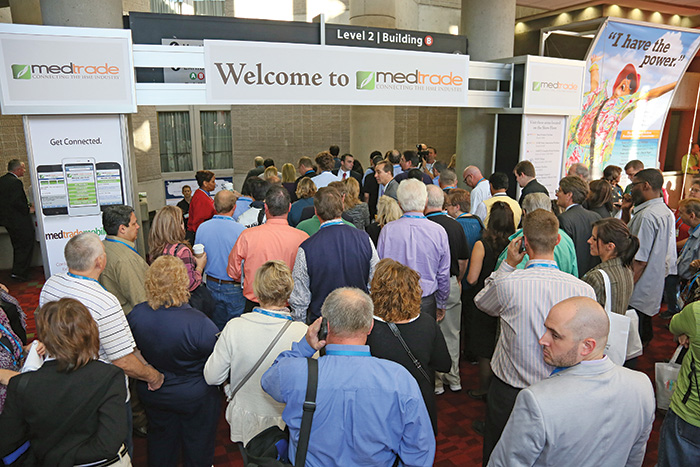On the surface, not much changed about the challenges facing the HME industry from October, 2011 to October, 2012—competitive bidding had been implemented, bringing with it much of the damage to small HME providers and to patient access that experts had predicted, and CMS continues to breed an atmosphere of mistrust and antagonism with ever-increasing audits. But the tone of Medtrade 2012 seemed much more positive compared to the previous year’s rather downbeat mood. HME providers are accustomed to living with adversity, and those that have survived the onslaught seem to be looking to the future with, if not enthusiasm, at least a modicum of hope. Medtrade 2012, which took place Oct. 15-18 in Atlanta, was a chance for these battle-hardened veterans to see the newest HME products, learn creative new business strategies and, perhaps most importantly, share their feelings and ideas about the new HME landscape with fellow providers.
Much of the legislative discussion centered around H.R. 6490, the House bill that would replace competitive bidding with the Market Pricing Program. Congressman Tom Price of Georgia made a special speaking appearance at the Welcome Reception, hosted by California-based MK Battery, prior to the opening of Medtrade 2012. The event also featured industry leaders from the National Coalition for Assistive and Rehab Technology (NCART), the National Registry of Rehabilitation Technology Suppliers (NRRTS) and the American Association for Homecare. Special guests included HME industry executives and representatives of nine national nonprofit health-care advocacy organizations that took part in Medtrade’s first-ever Consumer Advocacy Pavilion, also sponsored by MK Battery. Congressman Price provided an update on the H.R. 6490 bill and called on those in attendance to return to their districts and solicit more congressional sponsors for the bill.
The Medtrade Expo floor featured a number of special areas, both old favorites and new additions. The new Consumer Advocacy Pavilion included “Homecare Works! A Pathway to Better Affordable Care: A Learning Destination,” a scale model home that showcased HME products from various manufacturers in the setting in which they would be used along with the stories of two patients, their health issues and the ways in which the products on display help them remain at home. The pavilion also featured exhibits by advocacy organizations and associations such as the American Sleep Apnea Association, COPD Foundation, Item Coalition, Muscular Dystrophy Association, Paralyzed Veterans of America, The Shepherd Center, Touch the Future, United Cerebral Palsy Association and Users First, a Program of United Spinal.

The HME State Association Pavilion featured a host of state HME associations, whose representatives were available to discuss the associations’ important work and member benefits and to provide information about joining the groups. Most tables also seemed to feature a candy bowl—a welcome glycemic boost for weary Medtrade attendees and exhibitors.
One of the most popular attractions at recent shows is the New Product Pavilion, and this year was no exception. More than 45 companies displayed their newest, most innovative product offerings, and visitors to the pavilion were able to vote on their favorite products for Medtrade awards.
The Retail Design Center, presented in cooperation with VGM Group and KC Fixtures, is designed to help providers overcome the reimbursement challenges brought on by audits and competitive bidding by boosting their retail margin. There, visitors learned not only about profitable cash products, but also how to display them, how to communicate with customers in the retail arena and how to develop an engaging and profitable retail space.
As always, the World Series Beer Garden, sponsored by Infopia USA, was the place to relax with fellow attendees, take part in activities and giveaways and partake in traditional ballpark nosh like beer and hot dogs. The only thing missing was yelling at the umps.
As much as Medtrade is about seeing and experiencing products, it’s also about developing new skills and strategies to boost your bottom line. The conference schedule was packed with industry experts sharing valuable advice for improving billing and reimbursement efficiencies, boosting referrals, ensuring compliance, avoiding audits, implementing successful marketing plans and more. In addition to learning from experts, attendees had the opportunity to learn from their peers at the popular Lunch and Learn sessions, where moderators guided roundtable discussions on a variety of topics—from respiratory services to NSC requirements to medical documentation challenges—among a small group of fellow providers.
When the expo floor closed, it was time to kick off your sensible “tradeshow” shoes and put on your party shoes. Each night offered opportunities to network and socialize in a festive setting. Tuesday night’s AAHomecare Stand Up for Homecare reception—sponsored by HomeCare and Senior Care Products magazines—brought together veterans and activists from across the HME industry. A crowd packed the Ventanas event space to enjoy the view of downtown Atlanta from the floor-to-ceiling windows and roomy open-air patio, and to celebrate the 2012 Homecare Champion Award winners—Alan Landauer, chairman of Landauer Metropolitan, Inc., and Van G. Miller, founder and president of The VGM Group. Wednesday night’s agenda included a rocking Pride Mobility party at the Hard Rock Café and a pirate-themed bash hosted by VGM at the Hyatt Regency’s Centennial Ballroom, complete with tricorn hats, bandanas, pirate coins and an excellent pirate-costumed cover band.
When all was said and done, Medtrade 2012 was an exhausting but deeply affirming event. It proved once again that the HME industry, despite the challenges it faces, has the energy, resourcefulness and attitude to not just survive, but thrive. Whatever happens with CMS, more and more people will need the services that the HME industry provides, and they will learn what a crucial role it plays in the health-care continuum. As that happens, the HME community will only gain greater numbers of citizen advocates who care about the health of the industry. That’s a force to be reckoned with.
